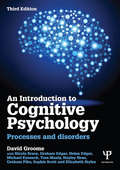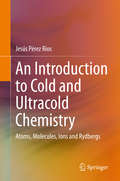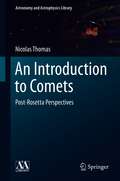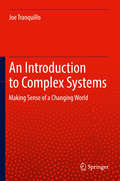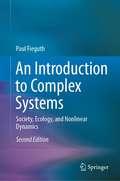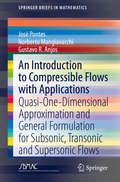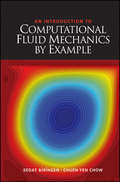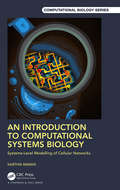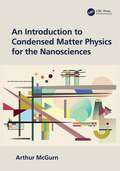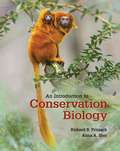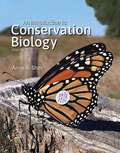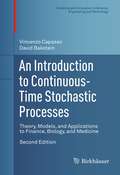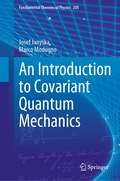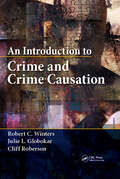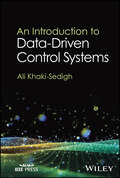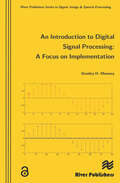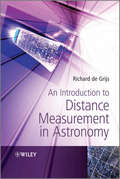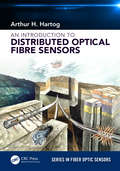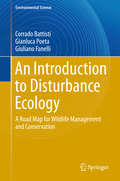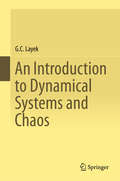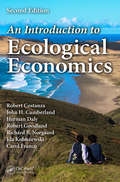- Table View
- List View
An Introduction to Cognitive Psychology: Processes and disorders
by David GroomeDavid Groome with Nicola Brace, Graham Edgar, Helen Edgar, Michael Eysenck, Tom Manly, Hayley Ness, Graham Pike, Sophie Scott, and Elizabeth Styles. An Introduction to Cognitive Psychology: Processes and Disorders is a comprehensive introductory textbook for undergraduate students. The third edition of this well-established text has been completely revised and updated to cover all the key areas of cognition, including perception, attention, memory, thinking and language. Uniquely, alongside chapters on normal cognitive function, there are chapters on related clinical disorders (agnosia, amnesia, thought disorder and aphasia) which help to provide a thorough insight into the nature of cognition. Key features: Completely revised and updated throughout to provide a comprehensive overview of current thinking in the field Accessibly written and including new authors, including Sophie Scott, Tom Manly, Hayley Ness, and Elizabeth Styles, all established experts in their field A new chapter on Emotion and Cognition, written by Michael Eysenck, the leading authority in the field Greater coverage of neuropsychological disorders, with additional material from the latest brain imaging research that has completely revolutionized neuropsychology Specially designed textbook features, chapter summaries, further reading, and a glossary of key terms A companion website featuring an extensive range of online resources for both teachers and students. Written to cover all levels of ability using helpful figures and illustrations, An Introduction to Cognitive Psychology has sufficient depth to appeal to the most able students while the clear and accessible text, written by experienced teachers, will help students who find the material difficult. It will appeal to any student on an undergraduate psychology degree course, as well as to medical students and those studying in related clinical professions such as nursing.
An Introduction to Cold and Ultracold Chemistry: Atoms, Molecules, Ions and Rydbergs
by Jesús Pérez RíosThis book provides advanced undergraduate and graduate students with an overview of the fundamentals of cold and ultracold chemistry. Beginning with definitions of what cold and ultracold temperatures mean in chemistry, the book then takes the student through the essentials of scattering theory (classical and quantum mechanical), light-matter interaction, reaction dynamics and Rydberg physics. The author aims to show the reader the richness of the topic while motivating students to understand the fundamentals of these intriguing reactions and underlying connecting relationships. Including material which was previously only found in specialized review articles, this book provides students working in the fields of ultracold gases, chemical physics and physical chemistry with the tools they need to immerse themselves in the realm of cold and ultracold chemistry. This book opens up the exciting chemical laws which govern chemistry at low temperatures to the next generation of researchers.
An Introduction to Comets: Post-Rosetta Perspectives (Astronomy and Astrophysics Library)
by Nicolas ThomasWritten by a leading expert on comets, this textbook is divided into seven main elements with a view to allowing advanced students to appreciate the interconnections between the different elements. The author opens with a brief introductory segment on the motivation for studying comets and the overall scope of the book. The first chapter describes fundamental aspects most usually addressed by ground-based observation. The author then looks at the basic physical phenomena in four separate chapters addressing the nucleus, the emitted gas, the emitted dust, and the solar wind interaction. Each chapter introduces the basic physics and chemistry but then new specific measurements by Rosetta instruments at comet Churyumov-Gerasimenko are brought in. A concerted effort has been made to distinguish between established fact and conjecture. Deviations and inconsistencies are brought out and their significance explained. Links to previous observations of comets Tempel 1, Wild 2, Hartley 2, Halley and others are made. The author then closes with three smaller chapters on related objects, the loss of comets, and prospects for future exploration. This textbook includes over 275 graphics and figures – most of which are original. Thorough explanations and derivations are included throughout the chapters. The text is therefore designed to support MSc. students and new PhD students in the field wanting to gain a solid overview of the state-of-the-art.
An Introduction to Complex Systems: Making Sense of a Changing World
by Joe TranquilloThis book explores the interdisciplinary field of complex systems theory. By the end of the book, readers will be able to understand terminology that is used in complex systems and how they are related to one another; see the patterns of complex systems in practical examples; map current topics, in a variety of fields, to complexity theory; and be able to read more advanced literature in the field. The book begins with basic systems concepts and moves on to how these simple rules can lead to complex behavior. The author then introduces non-linear systems, followed by pattern formation, and networks and information flow in systems. Later chapters cover the thermodynamics of complex systems, dynamical patterns that arise in networks, and how game theory can serve as a framework for decision making. The text is interspersed with both philosophical and quantitative arguments, and each chapter ends with questions and prompts that help readers make more connections.
An Introduction to Complex Systems: Society, Ecology, and Nonlinear Dynamics
by Paul FieguthComplex Systems lie at the heart of a variety of large-scale phenomena of great significance - global warming, ice ages, water, poverty, pandemics - and this text uses these case studies as motivations and contexts to explore complex systems and related topics of nonlinear dynamics and power-law statistics. Although detailed mathematical descriptions of these topics can be challenging, the consequences of a system being nonlinear, power-law, or complex are in fact quite accessible. This book blends a tutorial approach to the mathematical aspects of complex systems together with a complementary narrative on the global/ecological/societal implications of such systems. Nearly all engineering undergraduate courses focus on mathematics and systems which are small scale, linear, and Gaussian. Unfortunately there is not a single large-scale ecological or social phenomenon that is scalar, linear, and Gaussian. This book offers insights to better understand the large-scale problems facing the world and to realize that these cannot be solved by a single, narrow academic field or perspective. Instead, the book seeks to emphasize understanding, concepts, and ideas, in a way that is mathematically rigorous, so that the concepts do not feel vague, but not so technical that the mathematics get in the way. The book is intended for students in technical domains such as engineering, computer science, physics, mathematics, and environmental studies. This second edition adds nine new examples, over 30 additional problems, 50 additional figures, and three new chapters offering a detailed study of system decoupling, extensive solutions to chapter problems, and a timely discussion on the complex systems challenges associated with COVID-19 and pandemics in general.
An Introduction to Compressible Flows with Applications: Quasi-One-Dimensional Approximation and General Formulation for Subsonic, Transonic and Supersonic Flows (SpringerBriefs in Mathematics)
by José Pontes Norberto Mangiavacchi Gustavo R. AnjosThis book offers a concise and practical survey of the principles governing compressible flows, along with selected applications.It starts with derivation of the time-dependent, three-dimensional equation of compressible potential flows, and a study of weak waves, including evaluation of the sound speed in gases. The following chapter addresses quasi-one-dimensional flows, the study of normal shock waves, and flow in ducts with constant cross section subjected to friction and/or heat transfer. It also investigates the effects of friction and heat transfer in ducts with variable cross section. The chapter ends by pointing to the analogy between one-dimensional compressible flows and open channel hydraulics.Further, the book discusses supersonic flows, including the study of oblique shock waves, and supersonic flows over corners and wedges. It also examines Riemann problems, numerical resolution of the wave equation, and of nonlinear hyperbolic problems, including propagation of strong waves. A subsequent chapter focuses on the small perturbation theory of subsonic, transonic and supersonic flows around slender bodies aligned or almost aligned to the uniform inflow. In particular, it explores subsonic and supersonic flows over a wavy wall. Lastly, an appendix with a short derivation of the Fluid Mechanics basic equations is included.The final chapter addresses the problem of transonic flows where both subsonic and supersonic are present. Lastly, an appendix with a short derivation of the Fluid Mechanics basic equations is included.Illustrated with several practical examples, this book is a valuable tool to understand the most fundamental mathematical principles of compressible flows. Graduate Mathematics, Physics and Engineering students as well as researchers with an interest in the aerospace sciences benefit from this work.
An Introduction to Computational Fluid Mechanics by Example
by Chuen-Yen Chow Sedat BiringenThis new book builds on the original classic textbook entitled: An Introduction to Computational Fluid Mechanics by C. Y. Chow which was originally published in 1979. In the decades that have passed since this book was published the field of computational fluid dynamics has seen a number of changes in both the sophistication of the algorithms used but also advances in the computer hardware and software available. This new book incorporates the latest algorithms in the solution techniques and supports this by using numerous examples of applications to a broad range of industries from mechanical and aerospace disciplines to civil and the biosciences. The computer programs are developed and available in MATLAB. In addition the core text provides up-to-date solution methods for the Navier-Stokes equations, including fractional step time-advancement, and pseudo-spectral methods. The computer codes at the following website: www.wiley.com/go/biringen
An Introduction to Computational Systems Biology: Systems-Level Modelling of Cellular Networks (Chapman & Hall/CRC Computational Biology Series)
by Karthik Raman"This is a very comprehensive read that provides a solid base in computational biology. The book is structured in 4 parts and 14 chapters which cover all the way from the more basic concepts to advanced material, including the state-of-the-art methodologies in synthetic and systems biology. This is a bedside book for those researchers embarking to do investigation in computational biology and a great office companion for anyone working on systems and synthetic biology." -- Rodrigo Ledesma Amaro, Lecturer, Imperial College London "This is a fantastic book. It offers an elegant introduction to both classical and modern concepts in computational biology. To the uninitiated, it is a terrific first read, bringing alive the glory of the past and the promise of the future. To the interested, it handholds and offers a springboard to dive deep. To the practitioner, it serves as a valuable resource bringing together in a panoramic view many diverse streams that adorn the landscape." -- Narendra M. Dixit, Professor, Indian Institute of Science An Introduction to Computational Systems Biology: Systems-Level Modelling of Cellular Networks delivers a comprehensive and insightful account of applying mathematical modelling approaches to very large biological systems and networks—a fundamental aspect of computational systems biology. The book covers key modelling paradigms in detail, while at the same time retaining a simplicity that will appeal to those from less quantitative fields. Features A hands-on approach to modelling Covers a broad spectrum of modelling, from static networks to dynamic models and constraint-based models Thoughtful exercises to test and enable understanding of concepts State-of-the-art chapters on exciting new developments like community modelling and biological circuit design Emphasis on coding and software tools for systems biology This book is highly multi-disciplinary and will appeal to biologists, engineers, computer scientists, mathematicians and others.
An Introduction to Condensed Matter Physics for the Nanosciences
by Arthur McGurnThe book provides an accessible introduction to the principles of condensed matter physics with a focus on the nanosciences and device technologies. The basics of electronic, phononic, photonic, superconducting, optics, quantum optics, and magnetic properties are explored, and nanoscience and device materials are incorporated throughout the chapters. Many examples of the fundamental principles of condensed matter physics are taken directly from nanoscience and device applications. This book requires a background in electrodynamics, quantum mechanics, and statistical mechanics at the undergraduate level. It will be a valuable reference for advanced undergraduates and graduate students of physics, engineering, and applied mathematics. Features Contains discussions of the basic principles of quantum optics and its importance to lasers, quantum information, and quantum computation. Provides references and a further reading list to additional scientific literature so that readers can use the book as a starting point to then follow up with a more advanced treatment of the topics covered. Requires only a basic background in undergraduate electrodynamics, quantum mechanics, and statistical mechanics.
An Introduction to Conservation Biology
by Richard Primack Anna Sher<p>This is a book well suited for a wide range of undergraduate courses, as both a primary text for conservation biology courses and a supplement for ecological and environmental science courses. <p>New coauthor Anna Sher joins longtime Sinauer author Richard Primack in creating a book that combines the readability of Primack's A Primer of Conservation Biology with the depth and coverage of his larger textbook, Essentials of Conservation Biology. The result is a book well suited for a wide range of undergraduate courses, as both a primary text for conservation biology courses and a supplement for ecological and environmental science courses. <p>Using the chapter framework of the current Primer as a springboard, the authors have added three chapters focused on population biology conservation tools (Chapter 7), restoration ecology (Chapter 10), and the future of conservation (Chapter 12). Sustainable development, ex situ conservation, and other key topics have been expanded and updated with hundreds of new examples, explanations, citations, and figures to enhance learning and excitement for the subject. Dr. Sher has mined her experience of having taught conservation biology using Dr. Primack's texts for over a decade to fine-tune the presentation of difficult concepts, particularly in economics and politics. Coverage of recent conservation biology events in the news—such as the poaching of Cecil the Lion, the first papal encyclical on the environment, and the international Paris Accord on climate change—keeps the content fresh and current.</p>
An Introduction to Conservation Biology
by Anna SherAn Introduction to Conservation Biology is the only text designed for both aspiring conservation biologists and non-majors who are interested in this topical field, providing up-to-date perspectives on high-profile issues such as sustainable development, global warming, and strategies to save species on the verge of extinction. The book focuses successively on biological diversity and its value; threats to biological diversity; conservation at the population and species levels; protecting, managing and restoring ecosystems; and sustainable development. Each chapter is beautifully illustrated in full color with diverse examples from the current literature. Chapters begin with guiding conservation biology principles and end with study aids such as summaries, an annotated list of suggested readings, and discussion questions. Throughout, the authors maintain a focus on the active role that scientists, local people, conservation organizations, government, and the general public play in protecting biodiversity, even while providing for human needs.
An Introduction to Continuous-Time Stochastic Processes: Theory, Models, and Applications to Finance, Biology, and Medicine (Modeling and Simulation in Science, Engineering and Technology)
by Vincenzo Capasso David BaksteinThis textbook, now in its third edition, offers a rigorous and self-contained introduction to the theory of continuous-time stochastic processes, stochastic integrals, and stochastic differential equations. Expertly balancing theory and applications, the work features concrete examples of modeling real-world problems from biology, medicine, industrial applications, finance, and insurance using stochastic methods. No previous knowledge of stochastic processes is required. Key topics include:Markov processesStochastic differential equationsArbitrage-free markets and financial derivativesInsurance riskPopulation dynamics, and epidemicsAgent-based modelsNew to the Third Edition:Infinitely divisible distributionsRandom measuresLevy processesFractional Brownian motionErgodic theoryKarhunen-Loeve expansionAdditional applicationsAdditional exercisesSmoluchowski approximation of Langevin systemsAn Introduction to Continuous-Time Stochastic Processes, Third Edition will be of interest to a broad audience of students, pure and applied mathematicians, and researchers and practitioners in mathematical finance, biomathematics, biotechnology, and engineering. Suitable as a textbook for graduate or undergraduate courses, as well as European Masters courses (according to the two-year-long second cycle of the "Bologna Scheme"), the work may also be used for self-study or as a reference. Prerequisites include knowledge of calculus and some analysis; exposure to probability would be helpful but not required since the necessary fundamentals of measure and integration are provided. From reviews of previous editions:"The book is . . . an account of fundamental concepts as they appear in relevant modern applications and literature. . . . The book addresses three main groups: first, mathematicians working in a different field; second, other scientists and professionals from a business or academic background; third, graduate or advanced undergraduate students of a quantitative subject related to stochastic theory and/or applications. " -Zentralblatt MATH
An Introduction to Continuum Mechanics
by J. N. ReddyThis textbook reflects the modern view that scientists and engineers should be trained to think and work in multidisciplinary environments. Topics include derivations of the basic equations of invariant (vector and tensor) and form and specializations of the governing equations to various coordinate systems.
An Introduction to Covariant Quantum Mechanics (Fundamental Theories of Physics #205)
by Josef Janyška Marco ModugnoThis book deals with an original contribution to the hypothetical missing link unifying the two fundamental branches of physics born in the twentieth century, General Relativity and Quantum Mechanics. Namely, the book is devoted to a review of a "covariant approach" to Quantum Mechanics, along with several improvements and new results with respect to the previous related literature. The first part of the book deals with a covariant formulation of Galilean Classical Mechanics, which stands as a suitable background for covariant Quantum Mechanics. The second part deals with an introduction to covariant Quantum Mechanics. Further, in order to show how the presented covariant approach works in the framework of standard Classical Mechanics and standard Quantum Mechanics, the third part provides a detailed analysis of the standard Galilean space-time, along with three dynamical classical and quantum examples. The appendix accounts for several non-standard mathematical methods widely used in the body of the book.
An Introduction to Crime and Crime Causation
by Cliff Roberson Robert C. Winters Julie L. GlobokarAn Introduction to Crime and Crime Causation is a student-friendly textbook that defines and explains the concepts of crime, criminal law, and criminology. Ideal for a one-semester course, the book compares and contrasts early criminal behavior and today‘s modern forms of crime. It also explores society‘s responses to criminal behavior in the past
An Introduction to Data-Driven Control Systems
by Ali Khaki-SedighAn Introduction to Data-Driven Control Systems An introduction to the emerging dominant paradigm in control design Model-based approaches to control systems design have long dominated the control systems design methodologies. However, most models require substantial prior or assumed information regarding the plant’s structure and internal dynamics. The data-driven paradigm in control systems design, which has proliferated rapidly in recent decades, requires only observed input-output data from plants, making it more flexible and broadly applicable. An Introduction to Data-Driven Control Systems provides a foundational overview of data-driven control systems methodologies. It presents key concepts and theories in an accessible way, without the need for the complex mathematics typically associated with technical publications in the field, and raises the important issues involved in applying these approaches. The result is a highly readable introduction to what promises to become the dominant control systems design paradigm. Readers will also find: An overview of philosophical-historical issues accompanying the emergence of data-driven control systems Design analysis of several conventional data-driven control systems design methodologies Algorithms and simulation results, with numerous examples, to facilitate the implementation of methods An Introduction to Data-Driven Control Systems is ideal for students and researchers in control theory or any other research area related to plant design and production.
An Introduction to Design Arguments
by Benjamin C. JantzenThe history of design arguments stretches back to before Aquinas, who claimed that things which lack intelligence nevertheless act for an end to achieve the best result. Although science has advanced to discredit this claim, it remains true that many biological systems display remarkable adaptations of means to ends. Versions of design arguments have persisted over the centuries and have culminated in theories that propose an intelligent designer of the universe. This volume is the only comprehensive survey of 2,000 years of debate, drawing on both historical and modern literature to identify, clarify, and assess critically the many forms of design argument for the existence of God. It provides a neutral, informative account of the topic from antiquity to Darwin, and includes concise primers on probability and cosmology. It will be of great value to upper-level undergraduates and graduates in philosophy of religion, theology, and philosophy of science.
An Introduction to Digital Signal Processing
by Stanley MneneyAn Introduction to Digital Signal Processing aims at undergraduate students who have basic knowledge in C programming, Circuit Theory, Systems and Simulations, and Spectral Analysis. The book is focused on basic concepts of digital signal processing, MATLAB simulation and implementation on selected DSP hardware in which the candidate is introduced to the basic concepts first before embarking to the practical part which comes in the later chapters. Initially Digital Signal Processing evolved as a postgraduate course which slowly filtered into the undergraduate curriculum as a simplified version of the latter. The goal was to study DSP concepts and to provide a foundation for further research where new and more efficient concepts and algorithms can be developed. Though this was very useful it did not arm the student with all the necessary tools that many industries using DSP technology would require to develop applications. This book is an attempt to bridge the gap. It is focused on basic concepts of digital signal processing, MATLAB simulation and implementation on selected DSP hardware. The objective is to win the student to use a variety of development tools to develop applications. Contents• Introduction to Digital Signal processing.• The transform domain analysis: the Discrete-Time Fourier Transform• The transform domain analysis: the Discrete Fourier Transform• The transform domain analysis: the z-transform• Review of Analogue Filter• Digital filter design.• Digital Signal Processing Implementation Issues• Digital Signal Processing Hardware and Software• Examples of DSK Filter Implementation
An Introduction to Distance Measurement in Astronomy
by Richard De GrijsDistance determination is an essential technique in astronomy, and is briefly covered in most textbooks on astrophysics and cosmology. It is rarely covered as a coherent topic in its own right. When it is discussed the approach is frequently very dry, splitting the teaching into, for example, stars, galaxies and cosmologies, and as a consequence, books lack depth and are rarely comprehensive.Adopting a unique and engaging approach to the subject An Introduction to distance Measurement in Astronomy will take the reader on a journey from the solar neighbourhood to the edge of the Universe, discussing the range of distance measurements methods on the way. The book will focus on the physical processes discussing properties that underlie each method, rather than just presenting a collection of techniques.As well as providing the most compressive account of distance measurements to date, the book will use the common theme of distance measurement to impart basic concepts relevant to a wide variety of areas in astronomy/astrophysics.The book will provide an updated account of the progress made in a large number of subfields in astrophysics, leading to improved distance estimates particularly focusing on the underlying physics. Additionally it will illustrate the pitfalls in these areas and discuss the impact of the remaining uncertainties in the complete understanding of the Universes at large. As a result the book will not only provide a comprehensive study of distance measurement, but also include many recent advances in astrophysics.
An Introduction to Distributed Optical Fibre Sensors (Series in Fiber Optic Sensors)
by Arthur H. HartogThis book explains physical principles, unique benefits, broad categories, implementation aspects, and performance criteria of distributed optical fiber sensors (DOFS). For each kind of sensor, the book highlights industrial applications, which range from oil and gas production to power line monitoring, plant and process engineering, environmental monitoring, industrial fire and leakage detection, and so on. The text also includes a discussion of such key areas as backscattering, launched power limitations, and receiver sensitivity, as well as a concise historical account of the field’s development.
An Introduction to Disturbance Ecology: A Road Map for Wildlife Management and Conservation (Environmental Science and Engineering)
by Corrado Battisti Gianluca Poeta Giuliano FanelliThis book represents an introductory review of disturbance ecology and threat analysis, providing schematic concepts and approaches useful for work on sites that are affected by the impact of human actions. It is aimed at conservation and environmental practitioners, who will find tips for choosing methods and approaches when there are conflicts between the natural components and human activity. It is also addressed to students of applied ecology, ecosystem management, land-use planning and environmental impact assessment. It discusses a number of topics covered in the programs of many university courses related to basic ecology and ecology of disturbance, the latter constituting a field of great interest because of its implications and repercussions in applied territorial science. The book is divided into two parts: the first focuses on the theoretical and disciplinary framework of the ecology of disturbance, while the second is devoted to the analysis of anthropogenic threats. This, in particular, discusses the most recent approach, which uses a conventional nomenclature to allow a coarse-grained quantification and objective assessment of threat impact on different environmental components. Such an approach facilitates the comparison of hierarchically different events and, therefore, helps define the priorities for management and conservation strategies.
An Introduction to Dynamic Meteorology
by James R. HoltonThis revised text presents a cogent explanation of the fundamentals of meteorology, and explains storm dynamics for weather-oriented meteorologists. It discusses climate dynamics and the implications posed for global change. Formulas have been removed.
An Introduction to Dynamical Systems and Chaos
by G. C. LayekThe book discusses continuous and discrete systems in systematic and sequential approaches for all aspects of nonlinear dynamics. The unique feature of the book is its mathematical theories on flow bifurcations, oscillatory solutions, symmetry analysis of nonlinear systems and chaos theory. The logically structured content and sequential orientation provide readers with a global overview of the topic. A systematic mathematical approach has been adopted, and a number of examples worked out in detail and exercises have been included. Chapters 1-8 are devoted to continuous systems, beginning with one-dimensional flows. Symmetry is an inherent character of nonlinear systems, and the Lie invariance principle and its algorithm for finding symmetries of a system are discussed in Chap. 8. Chapters 9-13 focus on discrete systems, chaos and fractals. Conjugacy relationship among maps and its properties are described with proofs. Chaos theory and its connection with fractals, Hamiltonian flows and symmetries of nonlinear systems are among the main focuses of this book. Over the past few decades, there has been an unprecedented interest and advances in nonlinear systems, chaos theory and fractals, which is reflected in undergraduate and postgraduate curricula around the world. The book is useful for courses in dynamical systems and chaos, nonlinear dynamics, etc. , for advanced undergraduate and postgraduate students in mathematics, physics and engineering.
An Introduction to Ecological Economics
by Carol Franco Robert Costanza Herman Daly Robert Goodland Richard B Norgaard Ida Kubiszewski John H CumberlandFrom Empty-World Economics to Full-World EconomicsEcological economics explores new ways of thinking about how we manage our lives and our planet to achieve a sustainable, equitable, and prosperous future. Ecological economics extends and integrates the study and management of both "nature's household" and "humankind's household"-An Introduction to
An Introduction to Electrochemical Impedance Spectroscopy
by Ramanathan Srinivasan Fathima FasminThis book covers the fundamental aspects and the application of electrochemical impedance spectroscopy (EIS), with emphasis on a step-by-step procedure for mechanistic analysis of data. It enables the reader to learn the EIS technique, correctly acquire data from a system of interest, and effectively interpret the same. Detailed illustrations of how to validate the impedance spectra, use equivalent circuit analysis, and identify the reaction mechanism from the impedance spectra are given, supported by derivations and examples. MATLAB® programs for generating EIS data under various conditions are provided along with free online video lectures to enable easier learning. Features: Covers experimental details and nuances, data validation method, and two types of analysis – using circuit analogy and mechanistic analysis Details observations such as inductive loops and negative resistances Includes a dedicated chapter on an emerging technique (Nonlinear EIS), including code in the supplementary material illustrating simulations Discusses diffusion, constant phase element, porous electrodes, and films Contains exercise problems, MATLAB codes, PPT slide, and illustrative examples This book is aimed at senior undergraduates and advanced graduates in chemical engineering, analytical chemistry, electrochemistry, and spectroscopy.
